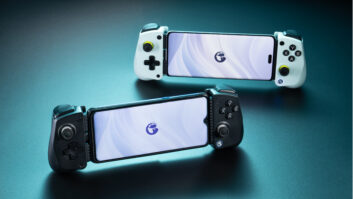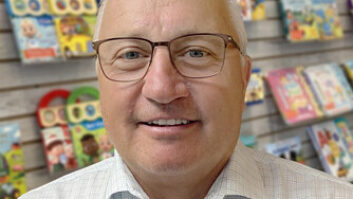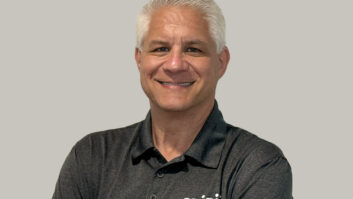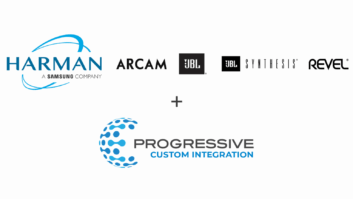TWICE:
If 2010 was the year of the
smartphone, is it safe to say that 2011
will be the year of the tablet?
Dan Schwab, D&H Distributing:
This year there will be dozens if
not hundreds of different applications
launched from 7-inch to 10-inch form
factors and smartphones using operating
systems from
HP’s Palm OS to
the Androids, including
the nextgeneration
Honeycomb
OS.
From a consumer-education standpoint,
tablets will be the wow product.
Everyone who has played with someone’s
iPad wants one. What will happen
is there will be a plethora of products.
Everyone will enter the category.
When digital cameras were first introduced
in the mid-’90s, dozens of people
entered. The same thing happened
with MP3 players, digital frames and
netbooks. It then settled back down
to the multinationals, to the five or so
players. That ultimately will happen in
this case as well.
There will be many different options
for the customer, but I personally believe
they will be in addition to, and not
instead of, other devices. People probably
will carry two devices, and shortterm,
they are very
apt to have three
— for instance, a
notebook for work
purposes, the
BlackBerry at all
times, and a tablet around the house.
That’s key this year from a customereducation
standpoint because there will
be so many options. It will be the hot category,
but there will be a lot of consumer
confusion over the right product and
when it’s the right time to buy it.
Michael Vitelli, Best Buy:
The applications
will have to move across all the
screens, the way iTunes works across
the iPhone, the iPad and the iPod.
Android will be the same way. There
are Android phones, Android tablets
and Android will be in notebooks. Android,
via Google, is also on TV, so applications
can move across four screens.
BlackBerry is trying to do the same
thing with the phone and the tablet, as
is Microsoft with Windows 7 – mobile
on a phone, mobile on a tablet and
mobile on a notebook, and they have
always wanted it to be on TV. Now HP
has also entered the market, and you
have five different operating systems.
At the end of the day, one would not
want to buy a tablet, but buy an operating
system that will move across all the
platforms. That is where it seems to be
heading. Then what has to happen is
whatever the mechanism is to sell to
you, or rent to you or let you have free
applications across that, it has to work
on every one of those screens.
That will lead to some interesting
software because it has to be scaled
to work on four different screen sizes.
It could be an Android big-screen application,
and the store might sell it
that way. But it’s absolutely changing
very, very quickly.
Fred Towns, New Age Electronics:
Amazon is doing something similar
with Kindle.
Paul Ryder, Amazon.com:
Philosophically,
Amazon as a company
thinks about the customer experience
and then it works backwards. Kindle
is no different. It was really about
one wanting to read a book — we are
device-agnostic. You own your books,
you are in the cloud, and you consume
them wherever you want on whatever
device you want. It is a fantastic strategy.
Apple has it with iTunes from way back, and whatever Apple device you
have all the music plays on it.
Amazon believed in that philosophy
for the Kindle. As new platforms
emerge, Kindle on that platform will
emerge with it because it’s just about
convenience. A lot of publications
thought the Kindle was dead once the
iPad came out, but it’s a single-purpose
device just like the GPS. I can take out
my phone and try to use it in my car
to get somewhere,
but the GPS is
actually better because
it was developed
100 percent
for that purpose.
The same thing holds true with the
Kindle. So if I want to sit down and
read for an hour, I prefer to do it on the
Kindle, but I may snack on a book out
in the hallway or at
the soccer field.
Towns:
The Kindle
is like the early
step of what Ultraviolet
is trying to do
for the movie side in making content
available to so many different devices.
The barrier was already broken
by saying, “Well, if you bought the
book, we will enable the book to be
put in so many different devices.”
When one talks about content,
there are people dealing with storage
and content, trying to grasp
their part of it. All the storage companies
are now putting their version
of an Apple TV together to be able
to take that content and move it
and share it. That is a big change.
Amazon was at the forefront of that
because of what was done with the
Kindle, taking that same content and
making it shareable among so many
different mediums and devices.
TWICE:
What role can distributors
play in moving A/V specialty
retailers into mobile broadband?
Schwab:
We think the role we
have to take is from an education
standpoint. We have had the luxury
of selling CE and IT for decades. We
have to help the dealers understand
and have taken as much of a leadership
role as possible with a digital
home guide on our website. The
guide shows how one can create
different solutions by combining IT
and CE products, and also features
virtual trade shows and events.
These products are not going to
be everything to everybody. What’s
key is retailers need more bullets to
differentiate themselves, to add value
to that transaction, to go back to the
customer and get them to transact or
upgrade and complete the solution.
A lot of the IT products first
started with wireless technology in
the home, but it really has grown
beyond that today. It is imperative
that retailers are merchandising the
full solution. They can’t sell the full
breadth of products, but they have
to be able to offer differentiated solutions
that add value and margin
and satisfy customer demand.
Towns:
We’ve tried to work with a
lot of the independents to bring them
up to speed on the offerings, noting
if they are not
currently in this
business, they
should get into
it. We are opening
up to different
dealers, who were willing to have an
open mind about it, to say this is how
this side of the business runs. You’re
missing a big opportunity by not having
it.
There is more of a need for education
on how to manage the life cycle
and the turns because the computing
product turns so rapidly. Our cycle
changes three times a year, and
that’s not typical for most consumer
products.
User interface is really key. A
smart guy five years ago said it
would all be about user interface. At
the end of the day, Apple was one of
the first to come out with a common
platform with a user interface across
all products. So companies like HP
and Samsung may not be sleeping —
they are looking at this very quickly
because they know it is their future.
Workman:
Retailers can get into
the business without necessarily having
entered the rest of the computer
business because it is developing
very quickly into its own category with
different utilization. It is important to
line up the supply chains and teach
the retailers how to live on 12 turns
times X margin with the proper set of
accessories, and quit worrying about
the individual margin on a device.
It’s an education process, and retailers
have to look for partners because
that’s a well-developed channel
with supply-chain logistics that
cater to the margin. Every retailer will
be in the computer business by the
end of 2011 whether they want to or
not, and they have to somehow figure
out how to be in that relationship.
They will all be in the tablet business
— they have to because it’s such a
transformative venue.
Retailers will also have to rethink
the margin on specific products. A
lot of times they will make the decision
to not enter a category because
the margin doesn’t work with their
SG&A, instead of not breaking it
down. In the e-reader business, if the
retailer looked at the little leatherette
cover that everybody needs to have,
they would notice they would make
10 points on the reader, but that
$39.95 cover, which costs $5 from
China, picks up that margin and it’s
not a bad sale.
The replacement warranty on it is
also an easy sale, and all of a sudden
there’s a pretty decent market basket
on a category that most retailers
today would say
they don’t want
to be in. Retailers
have to rethink
the building
blocks.
There are two places where there
is margin — content and solution. The
piece in the middle is continually being
squeezed in terms of margin. If
you’re not delivering content like the
Kindle delivers or you’re not on the
solution side, you have a challenge on
your hands in terms of just trying to sell
products. You can whine all you want,
but the margin trend will not be up.
Retailers have to figure out where
they will play their strength. Fortunately,
a lot of the retailers have focused
on the solution end of the
business. For every iPod that you
don’t make money on, a nice set of
headphones could be sold and a lot
of money could be made.
With the cellphone, the customer
can be regenerated every 18 months
back into the store with new technology.
The same trend is likely to
continue with tablets to where it becomes
net positive with all the innovation
going on.
Retailers have to approach these
categories differently in terms of how
they try to garner the dollars out of one
side. It will always be about basket. It
will always be about attachments. In
some categories, the challenge we
will face this year will be just pure
math where you take [average selling
price] times unit demand equals “I
don’t like that.” Every retailer needs to
step back from that and take charge
of their own destiny because otherwise,
just running down the curve as
it’s traveling right now, there’s probably
not a lot of dollar growth in some
of these big categories.













